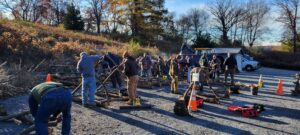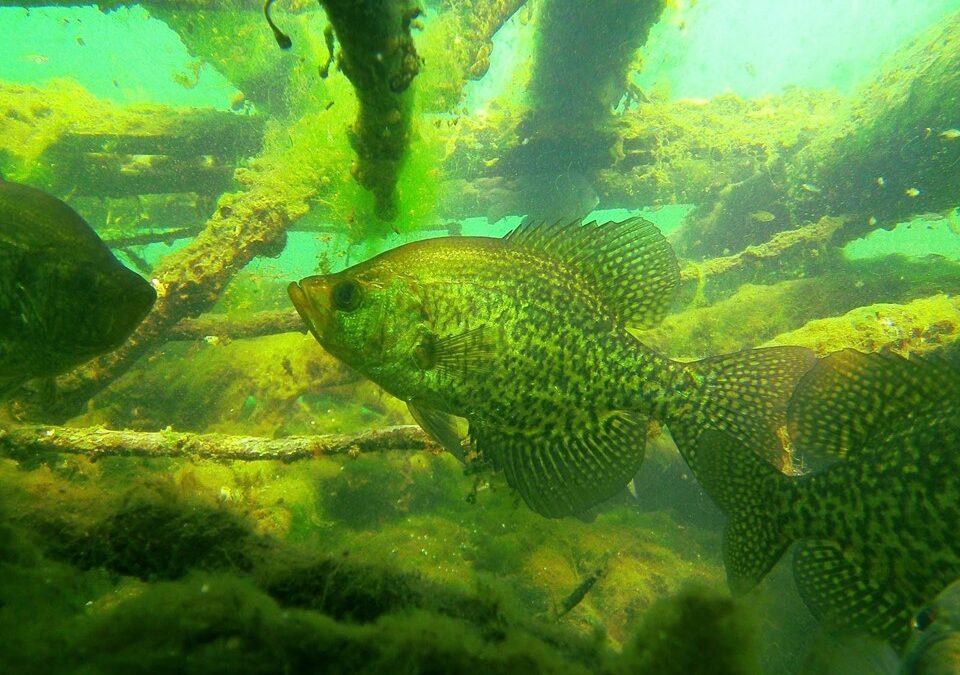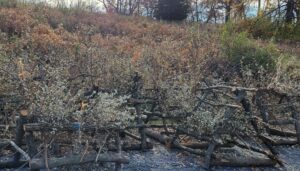Did you ever wonder what is at the bottom of Merrill Creek Reservoir (MCR)? Well let’s pull back the curtain – what is down there is: NOTHING. Yep, it’s a moonscape down there, rocks, rocks and more rocks. The reservoir was constructed by blasting into bedrock. Even along the shorelines, the sediment layers are so thin that not much, or if at all, does any vegetation grow. Some old standing dead trees are present along some of the shallower areas of the reservoir, but for the most part MCR contains little to no structure for algae to grow on or provide adequate refuge for smaller fish.
As with all wildlife management, habitat is the KEY to sustaining wildlife populations and providing certain types of structure to a species, or a suite of species, is the KEY to sustaining species for the long term. In fisheries management numerous scientific literature indicates: “structure provides surface area for organisms like macroinvertebrates and algae to grow on in addition to providing cover for fish. Structure also provides places for fish to hide, eat, or spawn.” Basically, structure provide a place for small organisms to grow and fish (usually small fish) to take refuge and hide from predators. Furthermore, as plants and animals begin to utilize structures, a waterbody’s food chain will benefit. Invertebrates will feed on the new algae that will grow on the structure, attracting forage fish, and those forage fish will attract predatory game fish species. Structure can be natural or artificial, with examples ranging from trees that have fallen into a waterbody or submerged vegetation to artificial underwater structures, such as fish cribs.

Members of MCCSA building fish cribs with materials harvested from MCR’s ecological forestry project
Working with MCR staff, Terra Engineering and the Merrill Creek Conservation and Sportsmen Association (MCCSA) utilized logs and branches from MCR’s recent ecological forest thinning project (i.e. another habitat enhancement and carbon defense project at MCR) to construct fish cribs to be deployed into the reservoir to provide structure in the reservoir. MCR staff consulted with the NJDFW Fisheries Division to determine the depths at which these cribs would be deployed and how these structures could be constructed. Additionally, as part of MCR’s exotic vegetative species management practices, which included the cutting and removal of the highly invasive Autumn olive (Elaeagnus umbellata) shrub, MCR utilized the cut Autumn Olive to fill the center of the cribs to provide additional structure to the crib, as well as to help with sinking the cribs (turns out Autumn Olive sinks like a stone as it does not float).
MCR would like to thank the members of MCCSA and Terra Engineering staff who participated in this project, as well as, for the guidance from the staff of NJDFW Fisheries Division. Between the deployment of these cribs (which will be an ongoing activity for years to come at MCR) and the felling of some large trees along the edge of the reservoir into the water to create additional structure in shallower areas of the reservoir, MCR believes that there will be a positive influence on the aquatic environment. These actions will help increase survival and promote growth of fish and macroinvertebrates, help with reproduction of some species, and increase protection from predators thus sustaining the biodiversity and species composition of the reservoir.
Efforts to monitor the cribs over time are currently be evaluated by MCR with the help of NJDFW.


